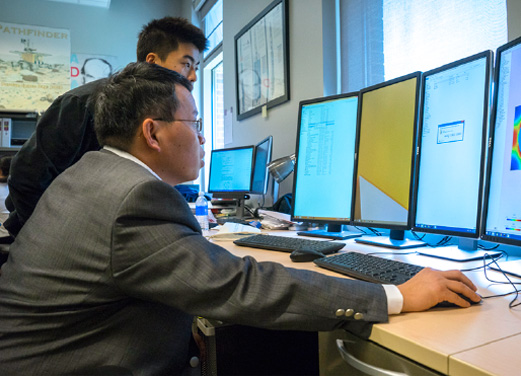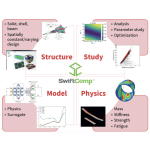Go Further with VABS using GEBT and PostGEBT
A companion code to VABS, GEBT (Geometrically Exact Beam Theory) is an independent general-purpose tool for analyzing geometric nonlinear behavior of slender structures. GEBT can enhance your use of VABS and implements the mixed variational formulation of the geometrically exact intrinsic beam theory developed by Prof. Dewey Hodges of Georgia Institute of Technology.
GEBT is a general-purpose tool for nonlinear analysis of composite slender structures, meeting the design challenges associated with future engineering systems featuring highly-flexible slender structures made of composites. GEBT is based on the mixed formulation of the geometric exact beam theory which can capture all geometric nonlinearities obtainable by a beam model due to large deflections and rotations, subject to the strains being small. Coupled with VABS (Variational Beam Sectional Analysis), a general-purpose cross-sectional analysis, GEBT can effectively analyze geometric nonlinear behavior of slender structures having arbitrary cross-sections made of arbitrary materials.
PostGEBT is a post-processing code which can effectively visualize mass data generated by the nonlinear beam solver GEBT. PostGEBT reads and visualizes the results produced by GEBT for static, steady-state, transient dynamic, and eigenvalue analyses. More details can be found in the PostGEBT user’s manual. PostGEBT is developed by Dr. Qi Wang of the National Renewable Energy Laboratory (NREL).
Both GEBT and PostGEBT are available for free download through the cdmHUB platform, hosted by Purdue University. Please visit the GEBT and PostGEBT pages to download GEBT or for additional information. You will also find a helpful discussion forum for technical questions about GEBT and PostGEBT.
VABS is a uniquely powerful approach to modeling composite blades and other slender structures (beams). VABS reduces analysis time from hours to seconds by quickly and easily achieving the accuracy of detailed 3D FEA with the efficiency of simple engineering models. With continuous development spanning over 20 years for performance and robustness, VABS is used in the aerospace and wind energy industries for modeling complex composite rotor blades, wing section design, and simulating other slender structures. VABS can accurately compute the complete set of beam sectional properties for slender structures featuring arbitrary cross-sectional shape and materials. It can reproduce the accuracy of direct numerical simulation using 3D FEA by explicitly modeling all the ply details of composite beams. In addition to PreVABS, VABS directly interfaces with ANSYS, ABAQUS, and others.
How can VABS help you?
- Unprecedented competitiveness through efficient, accurate modeling of real composite beams and other slender structures.
- Drastically reduced design cycle and time-to-market by saving orders of magnitude in design and analysis time.
- High fidelity results on a typical laptop computer, instead of a prohibitive detailed 3D FEA (even with heavy computing power).
- An enabling technology for nonlinear aeroelastic analysis of highly flexible structures.
1,000x FASTER
than 3D FEA for composite beam
Get the VABS Brochure
See the VABS Brochure for details about features and capabilities.
VABS Applications

MULTISCALE MODELING OF COMPOSITE BEAMS
- Helicopter rotor blades
- Wind turbine blades
- Propellers
- High-aspect ratio wings
- Golf clubs
- Fishing rods
- Other slender composite structures
VIRTUAL TESTING OF COMPOSITE BEAMS
- Complete set of best multiphysical properties: needed for static/dynamic analysis using beam elements.
- Complete set of accurate multiphysical 3D fields: analyze under coupled effects of thermal, mechanical, and electromagnetic fields.
- Material properties: no restrictions on material properties and can handle any material, including isotropic, orthotropic, and anisotropic materials.
- Highly optimized for efficiency: ply-level details of real blades can be modeled in seconds.
- Directly integrated into other design environments, including ANSYS, ABAQUS, and CATIA.
- Reap the full benefits of VABS using free companion code GEBT (1D beam analysis), which accepts the full stiffness matrix. PostGEBT, a postprocessor to GEBT is also available.

Unique Technology
VABS is a proven technology for an efficient alternative to detailed 3D FEA for composite beams. It is the only tool capable of rigorously decoupling an original 3D slender solid with complex microstructure (sophisticated cross section with or without spanwise heterogeneity) into a simple engineering beam model. As long as beam elements are used in the design (such as multibody dynamics simulation, aeroelastic simulation), VABS will compute the best stiffness constant (such as torsional stiffness) for the beam element. To deal with a composite wing/rotor, many 3D FEA rely on smearing many layers into one thick layer, which introduces significant errors and defeats the very purpose of being high fidelity. However, VABS can compute ply-level stress field without such approximations (achieving the accuracy as if 3D FEA models all the ply level details).








